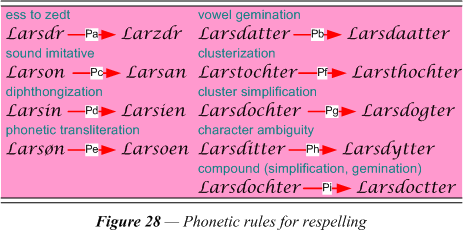
1.8 Respelling. As with accent, which is reflected in the dialect (D) dimension of phonetic analysis, respelling is due to the clerk who documents a person’s name spelling the sound of the name according to his own taste and inclination. It is the written system of a language and the speech-to-writing habits of a clerk in recording the name that brings about a respelling.

In the general sense “respelling” can arise in transcription because of confusion by the reader in interpreting an unfamiliar script, misreading it (V), or ineptness in the use of a QWERTY keyboard, mistyping it (Q). In modern times the written language of English is so developed or “corrupted” that respelling may be intentional on the part of the informant — perceived as inherent in the name itself and chosen in order to make it more distinctive. In the mind of the naive language user, however, the alternate spelling can merely be treated as a variant spelling, and not as a new name. The story is told of an Indiana mother who chose the name “DeMarcus” for her child, but spelled it “Marcus” on the birth certificate. Asked about the spelling she proclaimed that the “De” was to be taken as “invisible”!

The above diagram illustrates a number of examples of name variants that are due to the kind of variation inherent in the alphabet-to-sound system of English. There are many ways to spell a particular sound, so it is not always clear what the name bearer wants the correct spelling of his name to be. Notice that there are no cases of respelling where the pronunciation of the name changes. These would be classed as dialect variants (D). Presumably there are a relatively small number of minimal change transformations that could be expected to occur with certain names. It seems also that in some cases analogy and folk etymology are at work in spreading the popularity and promoting the readiness of certain respellings.
The study of Danish patronymic suffixes revealed that there are many variations that do not fit the mold of mistyping or misreading that must be spelling equivalents based on the pronunciation of the ending. Most of the examples in figure 28 belong here, though some of them could be argued to be mistyping (hitting the key twice, etc.). The double “a”, for example, is a normal spelling alternative for an open rounded “ah” sound; a dialect variant (D).

Figure 29 contains a number of examples of variants where the decision about whether it is respelling (P) or due to accent differences (D) may be difficult. It is easiest to make a case for the dialect dimension when the dominant accent attributes different pronunciations to the variant spellings. But it is also clear that some accents make no distinction between the variants with regard to pronunciation. This kind of uncertainty points to the need to account for spellings from the point of view of some standard accent; perhaps the prominent accent of the locale where and when the record was produced. In the case of “Meg” a better etymology might use vowel simplification by making its origin “Mag,” which must be assumed as the origin of the pet form “Maggie” anyway. R-dropping would have to been appealed to, but in a hidden step after truncation from “Margaret” to a hypothesized ”*Marg,” from which “Marge” comes through g-softening.

As mentioned above, respelling can easily be confused with mistyping (Q). It is possible to think that choice or ordering of letters may be due to the use of typewriter or other keyboard device for inputting names. Out of context this error is impossible to detect when the spelling happens to be a variant of some other name. Hence, two abbreviations might be confused: “Ferd.” (Ferdinand) may be written for “Fred.” (Frederick) and vice versa. When the name is longer, the mistyping is more likely to be detected, because it usually makes a rare spelling out of a recognizable one: “Wikkiam” for “William.”
